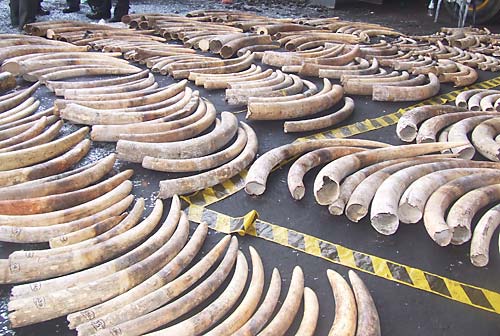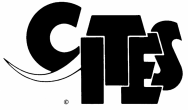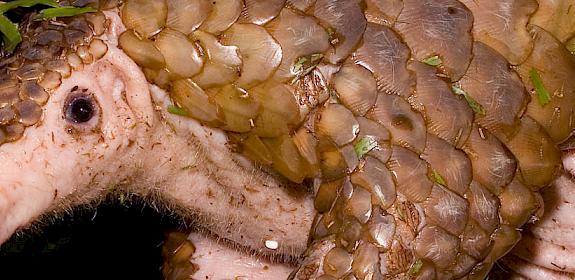Experts report highest elephant poaching and ivory smuggling rates in a decade
Geneva, 21st June 2012 – Elephant poaching levels are the worst in a decade and recorded ivory seizures are at their highest levels since 1989, according to a report published today by the Convention on International Trade in Endangered Species of Wild Fauna and Flora (CITES).

The findings, largely based on information submitted by governments, will be presented and discussed at the 62nd meeting of the CITES Standing Committee to be held in Geneva from 23 to 27 July 2012.
The report analyses data from the CITES programme on Monitoring the Illegal Killing of Elephants (MIKE), IUCN’s data on the status of elephant populations, the Elephant Trade Information System (ETIS) managed by TRAFFIC, and the CITES trade database managed by the UNEP World Conservation Monitoring Centre (UNEP-WCMC).
These authoritative sources of information have shown a very close correspondence between trends in elephant poaching and trends in large-scale ivory seizures, detecting essentially the same patterns at different points in the illegal ivory trade chain.
Commenting on the report, the CITES Secretary-General, Mr John E. Scanlon, said: “We need to enhance our collective efforts across range, transit and consumer states to reverse the current disturbing trends in elephant poaching and ivory smuggling. While being essential, enforcement efforts to stop wildlife crime must not just result in seizures – they must result in prosecutions, convictions and strong penalties to stop the flow of contraband. The whole ‘enforcement chain’ must work together.”
According to ETIS data, three of the five years in which the greatest volumes of ivory were seized globally occurred in 2009, 2010 and 2011.
In 2011 alone, there were 14 large-scale ivory seizures—a double-digit figure for the first time in 23 years, when ETIS records were first compiled. They totalled an estimated 24.3 tonnes of ivory; more than in any previous year.
Large-scale ivory seizures (those involving >800 kg of ivory in a single transaction), typically indicate the participation of organised crime.
China and Thailand are the two primary destinations for illegal ivory consignments exported from Africa according to the seizure data. Seizures of large ivory consignments in Malaysia, the Philippines and Viet Nam since 2009, were believed to be in transit to China and Thailand.
Some African and Asian countries have made significant efforts to enhance enforcement. For example, China conducted earlier this year a major operation which resulted in the seizure of 1,366.3 kg of ivory and the arrest of 13 suspects.
Most of the ivory smuggling containers leave the African continent through Indian Ocean seaports in East African countries, primarily Kenya and the United Republic of Tanzania.
“Evidence is steadily mounting which shows that African elephants are facing their most serious crisis since international commercial trade in ivory was generally prohibited under CITES in 1989”, said Tom Milliken, TRAFFIC’s Elephant and Rhino Programme Leader and the Director of ETIS.
These findings are matched by data on poaching levels in Africa from the CITES MIKE programme. MIKE has documented a steady increase in levels of elephant poaching across the continent since 2005, with the levels in 2011 being the highest since monitoring began in 2002.
Poaching levels are increasing in all countries where African elephants occur, and may be leading to dramatic declines in some populations, but particularly in Central African countries, where poaching levels are highest. This was brought to international attention earlier this year by the killing of hundreds of elephants in Bouba Ndjida National Park in Cameroon.
“MIKE analysis shows poaching to be highest where human livelihoods are most insecure and where governance and law enforcement are weakest. It also suggests that poaching is driven by demand for ivory in East Asia. The number of African elephants poached in 2011 alone could well run into the tens of thousands,” said Julian Blanc, who coordinates the MIKE programme.
Information collected by IUCN corroborates the MIKE findings that poaching is an immediate danger to elephant populations across the continent. There are disturbing indications that the illegal killing of elephants has increased in recent years in Asia too, although data are hard to obtain.
“There is a pressing need for governments and other stakeholders involved with wildlife conservation to properly assess the amount of Asian elephant ivory that is entering trade”, said Simon Hedges, Co-chair of the IUCN Species Survival Commission’s Asian Elephant Specialist Group.
An additional pressure on Asian elephants, also apparently increasing, is the illegal international commercial trade in live wild elephants for the circus trade in China and the tourist trade in Thailand.
The critical situation in Africa demonstrates the urgent need to implement the African Elephant Action Plan, which was created by all African elephant range States under the auspices of CITES in 2010. The plan envisages investing USD 100 million over three years into elephant conservation efforts, and an African Elephant Fund was launched in August 2011 at the 61st meeting of the CITES Standing Committee.
“Having sustainable elephant populations in Africa will require a shared vision and a highly strategic and collaborative investment of time and resources along the entire ivory supply chain. Without this we will all lose what we cherish the most – the icons of Africa – our elephants,” said Holly Dublin, Chair of the IUCN/SSC African Elephant Specialist Group, at a recent African elephant range States meeting.
At the international level, creative and innovative responses to this crisis are required. The use of modern traceability systems, including DNA forensics in cases of wildlife trafficking has already proven to be very effective. DNA evidence has been used successfully in a number of rhinoceros-related cases in South Africa and it is routinely forming a part of numerous criminal investigations. In any case, enforcement efforts to stop wildlife crime must be co-ordinated. The whole ‘enforcement chain’ must work together. This is why the work of the recently-established International Consortium to Combat Wildlife Crime (ICCWC) is essential to support and coordinate enforcement actions across international borders.
Notes:
The new report: ELEPHANT CONSERVATION, ILLEGAL KILLING AND IVORY TRADE
Background on elephants from IUCN elephant specialists groups
The most recent continent-wide compilation of African elephant (Loxodonta africana) numbers dates back to 2007, when there were at least half a million elephants in Africa, and perhaps as many as 700,000, spread over some 3.3 million km², an area slightly larger than India. New survey data on African elephant populations are currently being analysed by the IUCN/SSC African Elephant Specialist Group and entered into the new African and Asian Elephant Database (http://elephantdatabase.org), and an update on elephant numbers is expected later this year.
Listed in Appendix I of CITES and categorized as ‘endangered’ on the IUCN Red List of Threatened Species™, the global Asian elephant population is estimated at around 30,000–50,000, with a geographical range of around 878,600 km² (an area smaller than Pakistan), which is only 10% of the historical range.
Background on the ivory trade
The international trade in elephant ivory was banned by the Conference of the Parties to CITES in 1989. The CITES Parties have twice relaxed the ban since, first in 1999 to allow a “one-off” sale of ivory from Botswana, Namibia and Zimbabwe to Japan, and again in 2008 to allow further one-off sales from those three countries, plus South Africa, to China and Japan.
As a precondition for the second sale to go ahead, two monitoring systems – ETIS and MIKE – were established to monitor trends in levels of illegal trade in ivory and of illegal killing of elephants respectively. CITES also recognized the role of the IUCN Elephant Specialist Groups, which monitor the status of elephant populations, and UNEP-WCMC, which monitors the legal trade in ivory. Together, these four systems deliver consistent, evidence-based information to assist in CITES decision-making.
Convention on International Trade in Endangered Species of Wild Fauna and Flora (CITES)

The Convention on International Trade in Endangered Species of Wild Fauna and Flora, is an international agreement between governments that aims to ensure that international trade in specimens of wild animals and plants does not threaten their survival. Find out more here.
About TRAFFIC

TRAFFIC is a leading non-governmental organisation working to ensure that trade in wild species is legal and sustainable, for the benefit of the planet and people.
About IUCN

The International Union for Conservation of Nature (IUCN) is a membership Union uniquely composed of both government and civil society organisations. It provides public, private and non-governmental organisations with the knowledge and tools that enable human progress, economic development and nature conservation to take place together. For more information visit: iucn.org
About UNEP
The United Nations Environment Programme (UN Environment) is the leading global environmental authority that sets the global environmental agenda, promotes the coherent implementation of the environmental dimension of sustainable development within the United Nations system, and serves as an authoritative advocate for the global environment.




